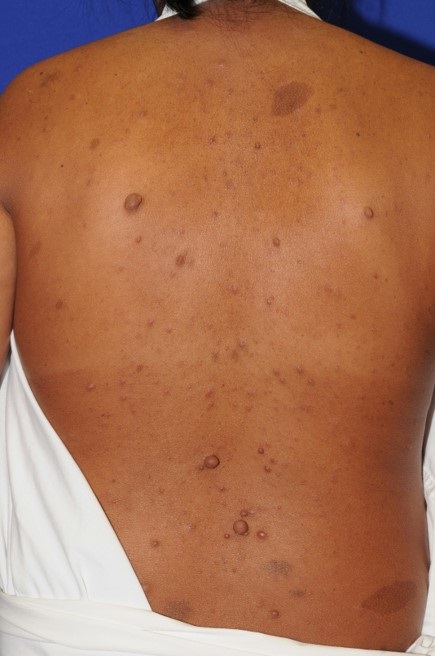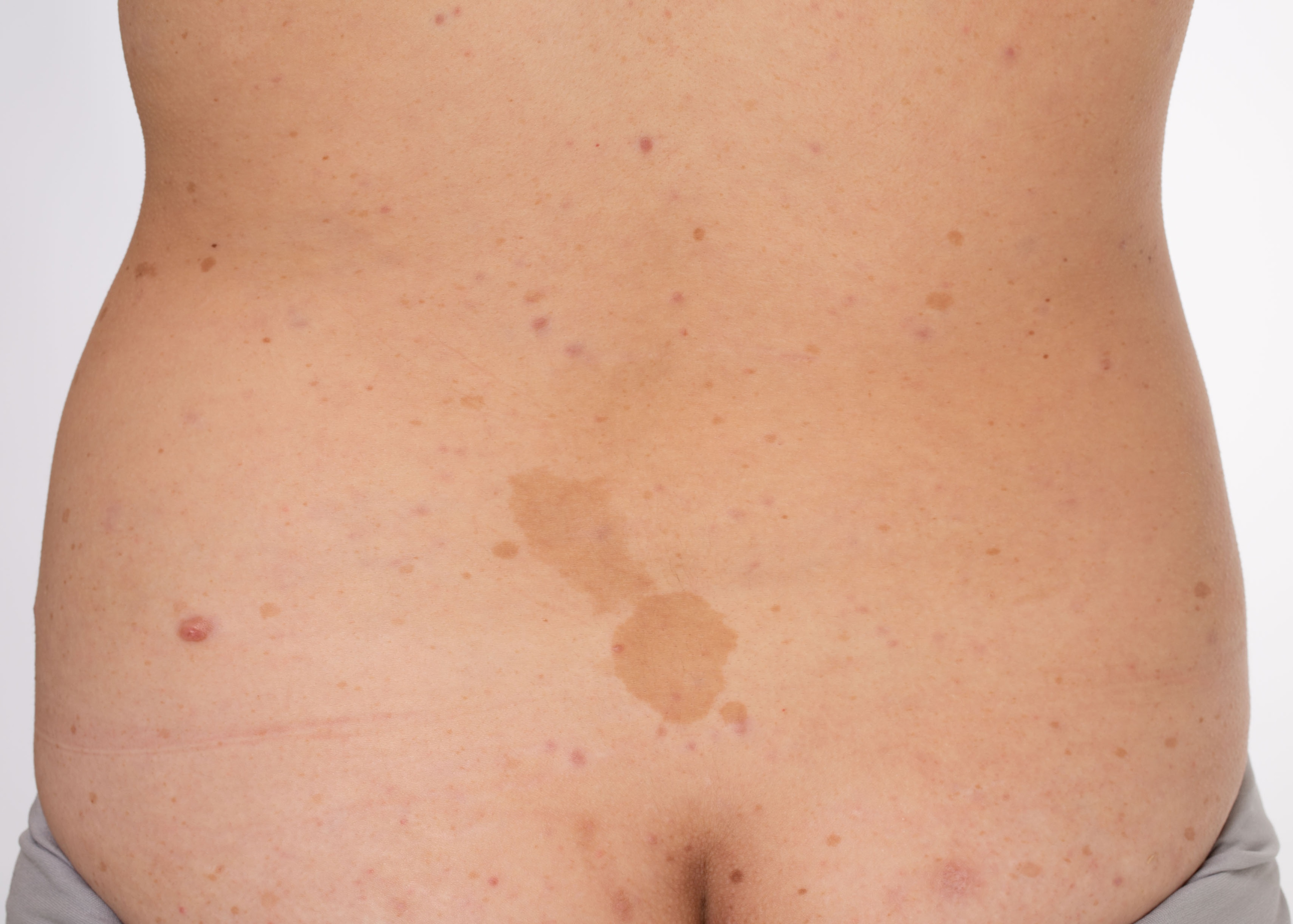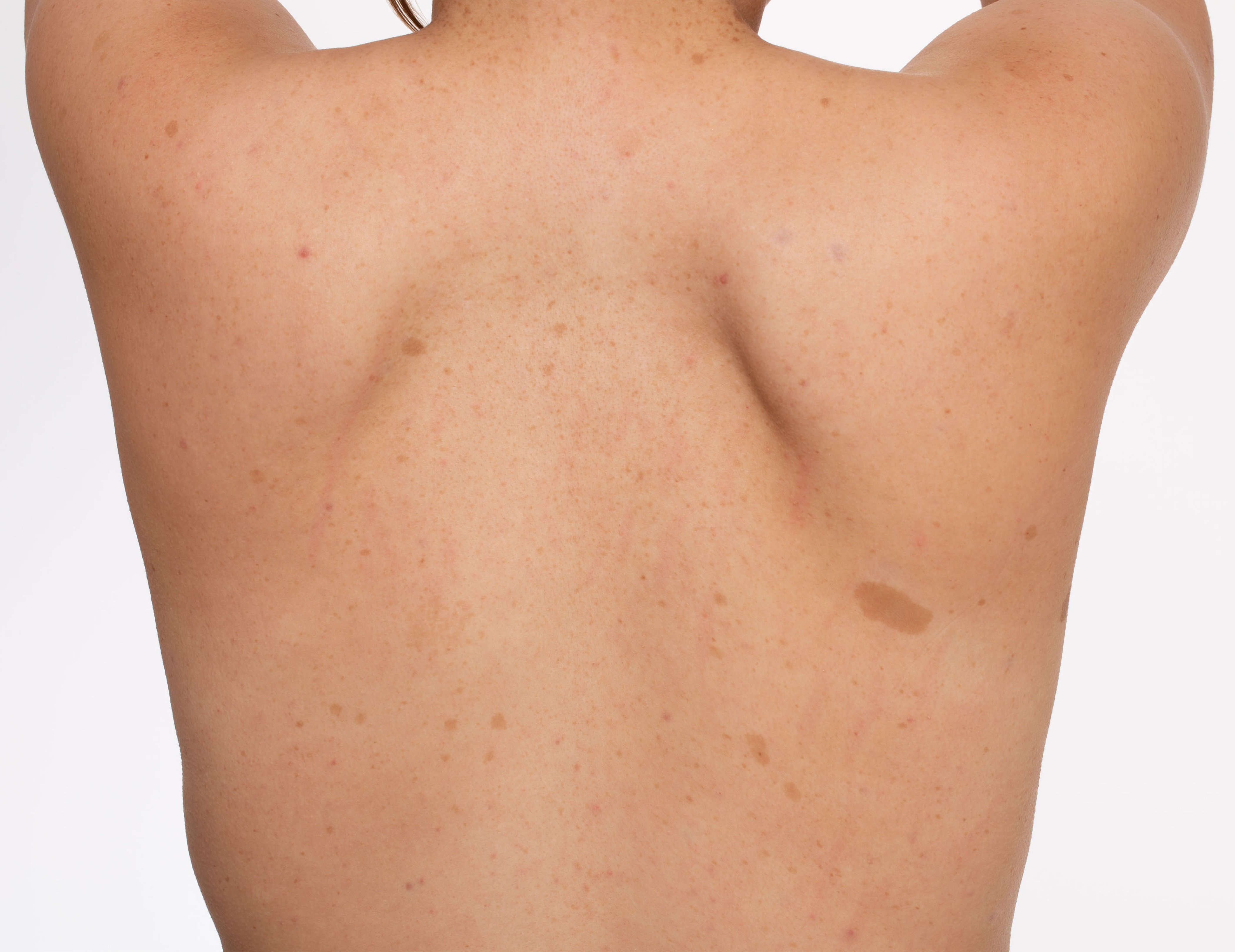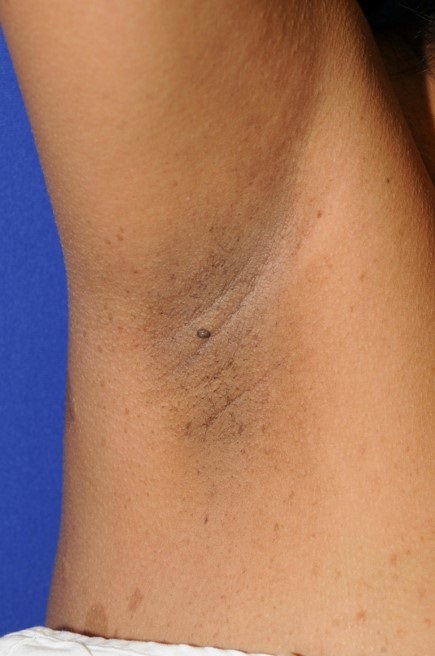[1]
Solares I,Vinal D,Morales-Conejo M, Diagnostic and follow-up protocol for adult patients with neurofibromatosis type 1 in a Spanish reference unit. Revista clinica espanola. 2022 Oct;
[PubMed PMID: 35688675]
[2]
Karaconji T,Whist E,Jamieson RV,Flaherty MP,Grigg JRB, Neurofibromatosis Type 1: Review and Update on Emerging Therapies. Asia-Pacific journal of ophthalmology (Philadelphia, Pa.). 2018 Nov 2;
[PubMed PMID: 30387339]
[3]
Farschtschi S,Mautner VF,McLean ACL,Schulz A,Friedrich RE,Rosahl SK, The Neurofibromatoses. Deutsches Arzteblatt international. 2020 May 15;
[PubMed PMID: 32657748]
[4]
Wang MX,Dillman JR,Guccione J,Habiba A,Maher M,Kamel S,Panse PM,Jensen CT,Elsayes KM, Neurofibromatosis from Head to Toe: What the Radiologist Needs to Know. Radiographics : a review publication of the Radiological Society of North America, Inc. 2022 Jul-Aug;
[PubMed PMID: 35749292]
[5]
Williams VC,Lucas J,Babcock MA,Gutmann DH,Korf B,Maria BL, Neurofibromatosis type 1 revisited. Pediatrics. 2009 Jan;
[PubMed PMID: 19117870]
[6]
Gutmann DH, Ferner RE, Listernick RH, Korf BR, Wolters PL, Johnson KJ. Neurofibromatosis type 1. Nature reviews. Disease primers. 2017 Feb 23:3():17004. doi: 10.1038/nrdp.2017.4. Epub 2017 Feb 23
[PubMed PMID: 28230061]
[7]
Ge LL,Xing MY,Zhang HB,Wang ZC, Neurofibroma Development in Neurofibromatosis Type 1: Insights from Cellular Origin and Schwann Cell Lineage Development. Cancers. 2022 Sep 17;
[PubMed PMID: 36139671]
[8]
Easton DF,Ponder MA,Huson SM,Ponder BA, An analysis of variation in expression of neurofibromatosis (NF) type 1 (NF1): evidence for modifying genes. American journal of human genetics. 1993 Aug
[PubMed PMID: 8328449]
[9]
Evans DG,Howard E,Giblin C,Clancy T,Spencer H,Huson SM,Lalloo F, Birth incidence and prevalence of tumor-prone syndromes: estimates from a UK family genetic register service. American journal of medical genetics. Part A. 2010 Feb;
[PubMed PMID: 20082463]
[10]
Stephens K,Kayes L,Riccardi VM,Rising M,Sybert VP,Pagon RA, Preferential mutation of the neurofibromatosis type 1 gene in paternally derived chromosomes. Human genetics. 1992 Jan
[PubMed PMID: 1346385]
[11]
Ruggieri M,Huson SM, The clinical and diagnostic implications of mosaicism in the neurofibromatoses. Neurology. 2001 Jun 12
[PubMed PMID: 11409413]
[12]
Theos A,Korf BR,American College of Physicians.,American Physiological Society., Pathophysiology of neurofibromatosis type 1. Annals of internal medicine. 2006 Jun 6
[PubMed PMID: 16754926]
[13]
Shah KN. The diagnostic and clinical significance of café-au-lait macules. Pediatric clinics of North America. 2010 Oct:57(5):1131-53. doi: 10.1016/j.pcl.2010.07.002. Epub
[PubMed PMID: 20888463]
[14]
Thomas S,Bikeyeva V,Abdullah A,Radivojevic A,Abu Jad AA,Ravanavena A,Ravindra C,Igweonu-Nwakile EO,Ali S,Paul S,Yakkali S,Teresa Selvin S,Hamid P, Systematic Review of Pediatric Brain Tumors in Neurofibromatosis Type 1: Status of Gene Therapy. Cureus. 2022 Aug;
[PubMed PMID: 36120213]
Level 1 (high-level) evidence
[15]
Kang E,Kim YM,Choi Y,Lee Y,Kim J,Choi IH,Yoo HW,Yoon HM,Lee BH, Whole-body MRI evaluation in neurofibromatosis type 1 patients younger than 3 years old and the genetic contribution to disease progression. Orphanet journal of rare diseases. 2022 Jan 29;
[PubMed PMID: 35093157]
[16]
Maertens O,Brems H,Vandesompele J,De Raedt T,Heyns I,Rosenbaum T,De Schepper S,De Paepe A,Mortier G,Janssens S,Speleman F,Legius E,Messiaen L, Comprehensive NF1 screening on cultured Schwann cells from neurofibromas. Human mutation. 2006 Oct
[PubMed PMID: 16941471]
[17]
Khajavi M,Khoshsirat S,Ahangarnazari L,Majdinasab N, A brief report of plexiform neurofibroma. Current problems in cancer. 2018 Mar - Apr
[PubMed PMID: 29449010]
[18]
He D,Li Y,Yu Y,Cai G,Ouyang F,Lin Y,Lu H,Chu L, Segmental neurofibromatosis type 1 complicated with multiple intracranial arteriovenous fistulas: A case study. Clinical neurology and neurosurgery. 2018 May;
[PubMed PMID: 29544172]
Level 3 (low-level) evidence
[19]
DeBella K,Szudek J,Friedman JM, Use of the national institutes of health criteria for diagnosis of neurofibromatosis 1 in children. Pediatrics. 2000 Mar
[PubMed PMID: 10699117]
[20]
Seminog OO,Goldacre MJ, Risk of benign tumours of nervous system, and of malignant neoplasms, in people with neurofibromatosis: population-based record-linkage study. British journal of cancer. 2013 Jan 15
[PubMed PMID: 23257896]
[22]
Nunley KS,Gao F,Albers AC,Bayliss SJ,Gutmann DH, Predictive value of café au lait macules at initial consultation in the diagnosis of neurofibromatosis type 1. Archives of dermatology. 2009 Aug
[PubMed PMID: 19687418]
[23]
Dugoff L,Sujansky E, Neurofibromatosis type 1 and pregnancy. American journal of medical genetics. 1996 Dec 2
[PubMed PMID: 8957502]
[24]
Prada CE,Rangwala FA,Martin LJ,Lovell AM,Saal HM,Schorry EK,Hopkin RJ, Pediatric plexiform neurofibromas: impact on morbidity and mortality in neurofibromatosis type 1. The Journal of pediatrics. 2012 Mar
[PubMed PMID: 21996156]
[25]
Lewis RA,Riccardi VM, Von Recklinghausen neurofibromatosis. Incidence of iris hamartomata. Ophthalmology. 1981 Apr
[PubMed PMID: 6789269]
[26]
Crawford AH,Herrera-Soto J, Scoliosis associated with neurofibromatosis. The Orthopedic clinics of North America. 2007 Oct
[PubMed PMID: 17945135]
[27]
Stevenson DA,Birch PH,Friedman JM,Viskochil DH,Balestrazzi P,Boni S,Buske A,Korf BR,Niimura M,Pivnick EK,Schorry EK,Short MP,Tenconi R,Tonsgard JH,Carey JC, Descriptive analysis of tibial pseudarthrosis in patients with neurofibromatosis 1. American journal of medical genetics. 1999 Jun 11;
[PubMed PMID: 10360395]
[28]
Lorenzo J,Barton B,Arnold SS,North KN, Developmental trajectories of young children with neurofibromatosis type 1: a longitudinal study from 21 to 40 months of age. The Journal of pediatrics. 2015 Apr
[PubMed PMID: 25598303]
[29]
Hyman SL,Shores A,North KN, The nature and frequency of cognitive deficits in children with neurofibromatosis type 1. Neurology. 2005 Oct 11
[PubMed PMID: 16217056]
[30]
Sánchez Marco SB,López Pisón J,Calvo Escribano C,González Viejo I,Miramar Gallart MD,Samper Villagrasa P, Neurological manifestations of neurofibromatosis type 1: our experience. Neurologia (Barcelona, Spain). 2022 Jun;
[PubMed PMID: 35672119]
[31]
Sheerin UM,Holmes P,London NF1 Research Group.,Childs L,Roy A,Ferner RE, Neurovascular complications in adults with Neurofibromatosis type 1: A national referral center experience. American journal of medical genetics. Part A. 2022 Oct;
[PubMed PMID: 36097643]
[32]
Créange A,Zeller J,Rostaing-Rigattieri S,Brugières P,Degos JD,Revuz J,Wolkenstein P, Neurological complications of neurofibromatosis type 1 in adulthood. Brain : a journal of neurology. 1999 Mar
[PubMed PMID: 10094256]
[33]
Ostendorf AP,Gutmann DH,Weisenberg JL, Epilepsy in individuals with neurofibromatosis type 1. Epilepsia. 2013 Oct
[PubMed PMID: 24032542]
[34]
Ferrari A,Bisogno G,Macaluso A,Casanova M,D'Angelo P,Pierani P,Zanetti I,Alaggio R,Cecchetto G,Carli M, Soft-tissue sarcomas in children and adolescents with neurofibromatosis type 1. Cancer. 2007 Apr 1
[PubMed PMID: 17330850]
[35]
Suarez-Kelly LP,Yu L,Kline D,Schneider EB,Agnese DM,Carson WE, Increased breast cancer risk in women with neurofibromatosis type 1: a meta-analysis and systematic review of the literature. Hereditary cancer in clinical practice. 2019
[PubMed PMID: 30962859]
Level 1 (high-level) evidence
[36]
Lewis RA,Gerson LP,Axelson KA,Riccardi VM,Whitford RP, von Recklinghausen neurofibromatosis. II. Incidence of optic gliomata. Ophthalmology. 1984 Aug;
[PubMed PMID: 6436764]
[37]
Guillamo JS,Créange A,Kalifa C,Grill J,Rodriguez D,Doz F,Barbarot S,Zerah M,Sanson M,Bastuji-Garin S,Wolkenstein P,Réseau NF France., Prognostic factors of CNS tumours in Neurofibromatosis 1 (NF1): a retrospective study of 104 patients. Brain : a journal of neurology. 2003 Jan
[PubMed PMID: 12477702]
Level 2 (mid-level) evidence
[38]
Fossali E,Signorini E,Intermite RC,Casalini E,Lovaria A,Maninetti MM,Rossi LN, Renovascular disease and hypertension in children with neurofibromatosis. Pediatric nephrology (Berlin, Germany). 2000 Aug
[PubMed PMID: 10955932]
[39]
Ejerskov C,Krogh K,Ostergaard JR,Joensson I,Haagerup A, Gastrointestinal Symptoms in Children and Adolescents With Neurofibromatosis Type 1. Journal of pediatric gastroenterology and nutrition. 2018 Jun
[PubMed PMID: 29240009]
[40]
Sethi NK,Chadha C,Goyal S,Kaur M, Neurofibromatosis 1: A family case series. Journal of family medicine and primary care. 2022 May;
[PubMed PMID: 35800488]
Level 2 (mid-level) evidence
[41]
García-Martínez FJ,Duat-Rodríguez,Andrés Esteban E,Torrelo,Noguera Morel L,Hernández-Martín, Cutaneous Manifestations not Considered Diagnostic Criteria for Neurofibromatosis Type 1. A Case-Control Study. Actas dermo-sifiliograficas. 2022 Sep 23;
[PubMed PMID: 36162491]
Level 2 (mid-level) evidence
[42]
Angelova-Toshkina D,Holzapfel J,Huber S,Schimmel M,Wieczorek D,Gnekow AK,Frühwald MC,Kuhlen M, Neurofibromatosis type 1: A comparison of the 1997 NIH and the 2021 revised diagnostic criteria in 75 children and adolescents. Genetics in medicine : official journal of the American College of Medical Genetics. 2022 Sep;
[PubMed PMID: 35713653]
[43]
Legius E,Messiaen L,Wolkenstein P,Pancza P,Avery RA,Berman Y,Blakeley J,Babovic-Vuksanovic D,Cunha KS,Ferner R,Fisher MJ,Friedman JM,Gutmann DH,Kehrer-Sawatzki H,Korf BR,Mautner VF,Peltonen S,Rauen KA,Riccardi V,Schorry E,Stemmer-Rachamimov A,Stevenson DA,Tadini G,Ullrich NJ,Viskochil D,Wimmer K,Yohay K,International Consensus Group on Neurofibromatosis Diagnostic Criteria (I-NF-DC).,Huson SM,Evans DG,Plotkin SR, Revised diagnostic criteria for neurofibromatosis type 1 and Legius syndrome: an international consensus recommendation. Genetics in medicine : official journal of the American College of Medical Genetics. 2021 Aug;
[PubMed PMID: 34012067]
Level 3 (low-level) evidence
[45]
Cutting LE,Koth CW,Burnette CP,Abrams MT,Kaufmann WE,Denckla MB, Relationship of cognitive functioning, whole brain volumes, and T2-weighted hyperintensities in neurofibromatosis-1. Journal of child neurology. 2000 Mar
[PubMed PMID: 10757470]
[46]
DiPaolo DP,Zimmerman RA,Rorke LB,Zackai EH,Bilaniuk LT,Yachnis AT, Neurofibromatosis type 1: pathologic substrate of high-signal-intensity foci in the brain. Radiology. 1995 Jun;
[PubMed PMID: 7754001]
[47]
Messiaen LM,Callens T,Mortier G,Beysen D,Vandenbroucke I,Van Roy N,Speleman F,Paepe AD, Exhaustive mutation analysis of the NF1 gene allows identification of 95% of mutations and reveals a high frequency of unusual splicing defects. Human mutation. 2000
[PubMed PMID: 10862084]
[48]
Barnett C,Candido E,Chen B,Pequeno P,Parkin PC,Tu K, Development of algorithms to identify individuals with Neurofibromatosis type 1 within administrative data and electronic medical records in Ontario, Canada. Orphanet journal of rare diseases. 2022 Aug 26;
[PubMed PMID: 36028856]
[49]
Nemmi F,Cignetti F,Assaiante C,Maziero S,Audic F,Péran P,Chaix Y, Discriminating between neurofibromatosis-1 and typically developing children by means of multimodal MRI and multivariate analyses. Human brain mapping. 2019 May 11;
[PubMed PMID: 31077476]
[50]
Guerrini-Rousseau L,Suerink M,Grill J,Legius E,Wimmer K,Brugières L, Patients with High-Grade Gliomas and Café-au-Lait Macules: Is Neurofibromatosis Type 1 the Only Diagnosis? AJNR. American journal of neuroradiology. 2019 May 9;
[PubMed PMID: 31072978]
[51]
Micieli R,Salsberg JM, Visual Dermatology: Mosaic Generalized Neurofibromatosis 1. Journal of cutaneous medicine and surgery. 2019 May/Jun;
[PubMed PMID: 31070102]
[52]
Petrák B,Bendová Š,Lisý J,Kraus J,Zatrapa T,Glombová M,Zámečník J, [Neurofibromatosis von Recklinghausen type 1 (NF1) - clinical picture and molecular-genetics diagnostic]. Ceskoslovenska patologie. 2015;
[PubMed PMID: 25671360]
[53]
Bhatia S,Chen Y,Wong FL,Hageman L,Smith K,Korf B,Cannon A,Leidy DJ,Paz A,Andress JE,Friedman GK,Metrock K,Neglia JP,Arnold M,Turcotte LM,de Blank P,Leisenring W,Armstrong GT,Robison LL,Clapp DW,Shannon K,Nakamura JL,Fisher MJ, Subsequent Neoplasms After a Primary Tumor in Individuals With Neurofibromatosis Type 1. Journal of clinical oncology : official journal of the American Society of Clinical Oncology. 2019 Nov 10
[PubMed PMID: 31532722]
[54]
Canavese F,Krajbich JI, Resection of plexiform neurofibromas in children with neurofibromatosis type 1. Journal of pediatric orthopedics. 2011 Apr-May;
[PubMed PMID: 21415691]
[55]
Dombi E,Baldwin A,Marcus LJ,Fisher MJ,Weiss B,Kim A,Whitcomb P,Martin S,Aschbacher-Smith LE,Rizvi TA,Wu J,Ershler R,Wolters P,Therrien J,Glod J,Belasco JB,Schorry E,Brofferio A,Starosta AJ,Gillespie A,Doyle AL,Ratner N,Widemann BC, Activity of Selumetinib in Neurofibromatosis Type 1-Related Plexiform Neurofibromas. The New England journal of medicine. 2016 Dec 29
[PubMed PMID: 28029918]
[56]
Lassaletta A,Scheinemann K,Zelcer SM,Hukin J,Wilson BA,Jabado N,Carret AS,Lafay-Cousin L,Larouche V,Hawkins CE,Pond GR,Poskitt K,Keene D,Johnston DL,Eisenstat DD,Krishnatry R,Mistry M,Arnoldo A,Ramaswamy V,Huang A,Bartels U,Tabori U,Bouffet E, Phase II Weekly Vinblastine for Chemotherapy-Naïve Children With Progressive Low-Grade Glioma: A Canadian Pediatric Brain Tumor Consortium Study. Journal of clinical oncology : official journal of the American Society of Clinical Oncology. 2016 Oct 10;
[PubMed PMID: 27573663]
[57]
Zhu B,Wei C,Wang W,Gu B,Li Q,Wang Z, [Treatment and progress of cutaneous neurofibroma]. Zhongguo xiu fu chong jian wai ke za zhi = Zhongguo xiufu chongjian waike zazhi = Chinese journal of reparative and reconstructive surgery. 2022 Sep 15;
[PubMed PMID: 36111466]
[58]
Greggi T,Martikos K, Surgical treatment of early onset scoliosis in neurofibromatosis. Studies in health technology and informatics. 2012
[PubMed PMID: 22744522]
[59]
Lemogne C,Bellivier F,Fakra E,Yon L,Limosin F,Consoli SM,Lantieri L,Hivelin M, Psychological and psychiatric aspects of face transplantation: Lessons learned from the long-term follow-up of six patients. Journal of psychosomatic research. 2019 Apr
[PubMed PMID: 30947816]
[60]
Roth J,Ber R,Constantini S, Neurofibromatosis type 1 related hydrocephalus: treatment options and considerations. World neurosurgery. 2019 May 3;
[PubMed PMID: 31059857]
[61]
Armand ML,Taieb C,Bourgeois A,Bourlier M,Bennani M,Bodemer C,Wolkenstein P, Burden of adult neurofibromatosis 1: development and validation of a burden assessment tool. Orphanet journal of rare diseases. 2019 May 3;
[PubMed PMID: 31053133]
Level 1 (high-level) evidence
[62]
Bellampalli SS,Khanna R, Towards a neurobiological understanding of pain in neurofibromatosis type 1: mechanisms and implications for treatment. Pain. 2019 May;
[PubMed PMID: 31009417]
Level 3 (low-level) evidence
[63]
Messiaen L,Yao S,Brems H,Callens T,Sathienkijkanchai A,Denayer E,Spencer E,Arn P,Babovic-Vuksanovic D,Bay C,Bobele G,Cohen BH,Escobar L,Eunpu D,Grebe T,Greenstein R,Hachen R,Irons M,Kronn D,Lemire E,Leppig K,Lim C,McDonald M,Narayanan V,Pearn A,Pedersen R,Powell B,Shapiro LR,Skidmore D,Tegay D,Thiese H,Zackai EH,Vijzelaar R,Taniguchi K,Ayada T,Okamoto F,Yoshimura A,Parret A,Korf B,Legius E, Clinical and mutational spectrum of neurofibromatosis type 1-like syndrome. JAMA. 2009 Nov 18;
[PubMed PMID: 19920235]
[64]
Asthagiri AR,Parry DM,Butman JA,Kim HJ,Tsilou ET,Zhuang Z,Lonser RR, Neurofibromatosis type 2. Lancet (London, England). 2009 Jun 6
[PubMed PMID: 19476995]
[66]
Wimmer K,Rosenbaum T,Messiaen L, Connections between constitutional mismatch repair deficiency syndrome and neurofibromatosis type 1. Clinical genetics. 2017 Apr
[PubMed PMID: 27779754]
[67]
Taylor LA,Lewis VL Jr, Neurofibromatosis Type 1: Review of Cutaneous and Subcutaneous Tumor Treatment on Quality of Life. Plastic and reconstructive surgery. Global open. 2019 Jan;
[PubMed PMID: 30859021]
Level 2 (mid-level) evidence
[68]
Yoshida Y,Ehara Y,Koga M,Imafuku S, Health-related quality of life in patients with neurofibromatosis 1 in Japan: A questionnaire survey using EQ-5D-5L. The Journal of dermatology. 2022 Jul 3;
[PubMed PMID: 35781730]
Level 2 (mid-level) evidence
[69]
Evans DGR,Kallionpää RA,Clementi M,Trevisson E,Mautner VF,Howell SJ,Lewis L,Zehou O,Peltonen S,Brunello A,Harkness EF,Wolkenstein P,Peltonen J, Breast cancer in neurofibromatosis 1: survival and risk of contralateral breast cancer in a five country cohort study. Genetics in medicine : official journal of the American College of Medical Genetics. 2020 Feb
[PubMed PMID: 31495828]
[70]
de Blank P,Li N,Fisher MJ,Ullrich NJ,Bhatia S,Yasui Y,Sklar CA,Leisenring W,Howell R,Oeffinger K,Hardy K,Okcu MF,Gibson TM,Robison LL,Armstrong GT,Krull KR, Late morbidity and mortality in adult survivors of childhood glioma with neurofibromatosis type 1: report from the Childhood Cancer Survivor Study. Genetics in medicine : official journal of the American College of Medical Genetics. 2020 Nov
[PubMed PMID: 32572180]
[71]
Doser K,Hove H,Østergaard JR,Bidstrup PE,Dalton SO,Handrup MM,Ejerskov C,Krøyer A,Doherty MA,Møllegaard Jepsen JR,Mulvihill JJ,Winther JF,Kenborg L, Cohort profile: life with neurofibromatosis 1 - the Danish NF1 cohort. BMJ open. 2022 Sep 20;
[PubMed PMID: 36127120]
[72]
Acar S,Nieblas-Bedolla E,Armstrong AE,Hirbe AC, A Systematic Review of Recent and Ongoing Clinical Trials in Patients With the Neurofibromatoses. Pediatric neurology. 2022 Sep;
[PubMed PMID: 35759947]
Level 1 (high-level) evidence
[73]
Miller DT,Freedenberg D,Schorry E,Ullrich NJ,Viskochil D,Korf BR,COUNCIL ON GENETICS.,AMERICAN COLLEGE OF MEDICAL GENETICS AND GENOMICS., Health Supervision for Children With Neurofibromatosis Type 1. Pediatrics. 2019 May
[PubMed PMID: 31010905]
[74]
Petr EJ,Else T, Pheochromocytoma and Paraganglioma in Neurofibromatosis type 1: frequent surgeries and cardiovascular crises indicate the need for screening. Clinical diabetes and endocrinology. 2018
[PubMed PMID: 29977594]
[75]
Rea D,Brandsema JF,Armstrong D,Parkin PC,deVeber G,MacGregor D,Logan WJ,Askalan R, Cerebral arteriopathy in children with neurofibromatosis type 1. Pediatrics. 2009 Sep
[PubMed PMID: 19706560]
[76]
Wang ZC,Li HB,Wei CJ,Wang W,Li QF, Community-boosted neurofibromatosis research in China. The Lancet. Neurology. 2022 Sep;
[PubMed PMID: 35963255]
[77]
Purdenko TI,Delva MY,Ostrovskaya LI,Tarianyk KA,Sylenko HY,Pushko OO,Purdenko SV, NEUROFIBROMATOSIS TYPE I AND ITS DIAGNOSTIC CRITERIA: A CLINICAL OBSERVATION. Wiadomosci lekarskie (Warsaw, Poland : 1960). 2022;
[PubMed PMID: 35758466]





